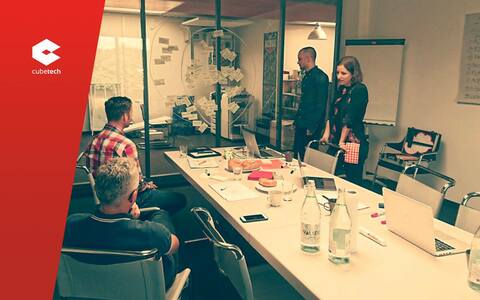With omnipresent digitalization, enterprises of all sizes are trying to keep up with ever-changing market tendencies. .
So, when the concept of Agile vibrates in every corner, not surprisingly, each industry is just eager to incorporate the methodology the quick and smooth way possible.
Here come Agile ceremonies, the power that keeps moving a team toward success. In today’s post, we are going to examine four major Agile ceremonies and discuss why business needs them.
With this article, you will learn the following:
- Agile Ceremony: Definition, Key Players, Functions
- The First Ceremony: Sprint Planning
- The Second Ceremony: Daily Stand-Up
- The Third Ceremony: Sprint Review
- The Fourth Ceremony: Sprint Retrospective
Before reading the article, we suggest you familiarize yourself with our company by watching the video.
Agile Ceremony: Definition, Key Players, Functions
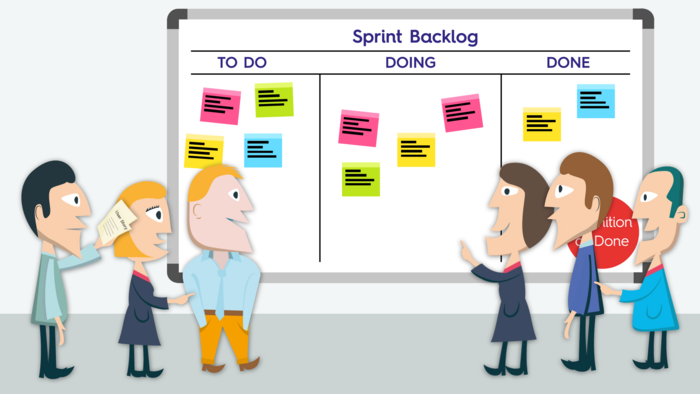
Agile ceremonies (events or meetings, as they are sometimes called) are specific Agile components designed to reach the maximum level of transparency and collaboration during any iterative development process. Normally, such ceremonies are distinguished by a clear structure and objective, the features that tend to organize project complexity and bring harmony to any workflow.
Note 1: there is no need to perform all the ceremonies, they are optional. Teams choose whatever suits them better and start benefiting right away. The crucial thing here is that they follow a specific system.
Note 2: originally conceived as Scrum events only, now the ceremonies can be easily applied to any Agile methodology like Kanban or the mixed ones. Such events involve a unique approach with the aim to empower a team and deliver a project in time, though the names of ceremonies may be different.
Migrate to secure hosting
Don't waste your time on Redmine maintenance. Hire experts and focus on your projects
Now it is time to review the key players in each Agile ceremony:
1. Development Team. Not limited only to technical specialists, the development team consists of cross-functional workers from a variety of professions, including designers, writers, programmers, etc. They determine on their own the amount of work they can make during one Agile sprint and collaborate on tasks afterwards. That is, an Agile developer means a team member with specific skills needed to successfully deliver a product.
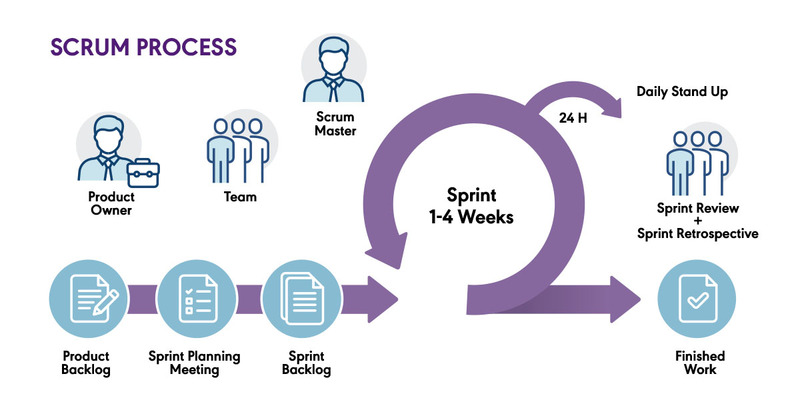
2. Product Owner. This person identifies customer needs and business requirements so that it is possible to create a product backlog based on these details. In fact, it is him who represents business and its value, prioritizes work, and assigns tasks to the development team. For this reason, the relationship between these two roles should be based on boundless trust and empathy. Moreover, the product owner is in charge of finding a subtle balance between all the stakeholders and their demands.
3. Scrum Master. It is a servant leader, the main function of which is to provide the greatest level of work efficiency. By this we mean that the Agile specialist is needed to create a supportive environment for Agile ceremonies and find the common language with other team members. It involves guiding a team through possible pitfalls.
We should keep in mind that the Agile essence lies in self-management and continuous self-development, that is why these three roles suggest a bare minimum of information what responsibilities each role contains. Thus, they enable teams to take responsibility themselves and make reasonable decisions.
Again, as everything in Agile, the roles are optional in every specific case. Different employees are able to perform various roles, but the whole team must be notified who is taking on each role today.
Learn more about RedmineUP Solutions!
The First Ceremony: Sprint Planning
The first event implies a team discussion on what should be done in the upcoming sprint and which human or other resources should be selected to achieve a better result.
How is it structured?
The planning phase starts when the Product Owner brings the product backlog, which must contain all the information necessary for story point estimations, as the topic for his further conversation with the Development Team. The Scrum Master oversees the whole meeting.
When does it start and how long does it take?
Since it is only about planning things, the ceremony starts at the beginning of a sprint and normally takes around 1h per week.
What parties are involved?
All the parties are involved: the Development Team, Product Owner, and Scrum Master.
How to manage the ceremony properly?
First of all, the Product Owner should determine the sprint goal and prioritize the product backlog so that the Team is able to estimate the quantity of effort required and come to a realistic conclusion on how much they can cover within this sprint. To continue, the team members should divide the prioritized tasks and add them to the project backlog.
By the way, the RedmineUP’s Agile plugin comes with a built-in Sprint planner that significantly facilitates the sprint planning process. In one click, users can rearrange issues by using drag and drop. Also, they see a big picture: the tasks, the general backlog, the total time score, the current sprint.
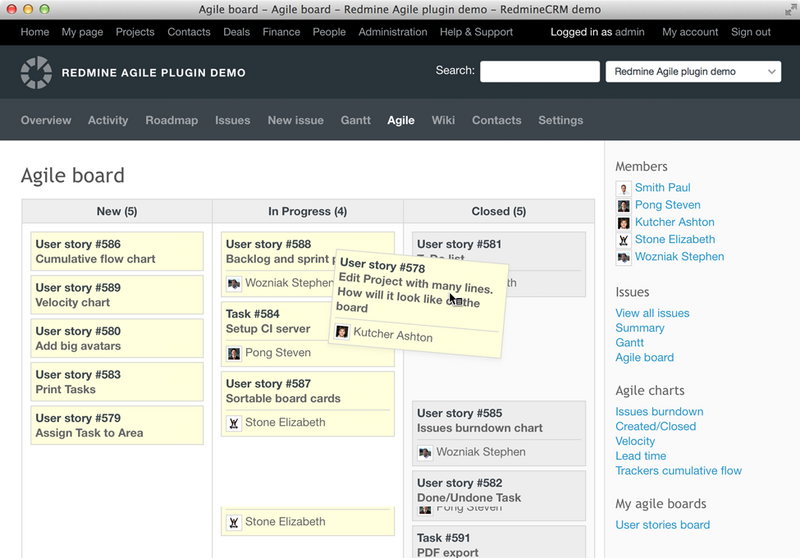
Top-3 Tips:
- It is not a competition at all. Be attentive to what other colleagues suggest and remember that you are a team, not just a group of professionals.
- Focus on what really matters. Which tasks are important right now and which ones are just out of this sprint’s scope?
- Be concise. Do not waste your and others time. Use time limits.
The Second Ceremony: Daily Stand-Up
The second event represents a daily team meeting (or a call if you are working remotely) when every team member shares his updates with the rest of a group.
How is it structured?
In a pretty informal way, workers report briefly what they have done the day before and what they are doing now. If required, they ask for help or advice.
When does it start and how long does it take?
Every day in the morning, no longer than 15-20 min.
What parties are involved?
The Development Team, Scrum Master. The presence of the Product Owner is optional.
How to manage the ceremony properly?
Again, with the help of a project management tool, users can filter the current sprint board by clicking on the button Assignee to see the progress of each employee. This way, your efforts will be accountable.
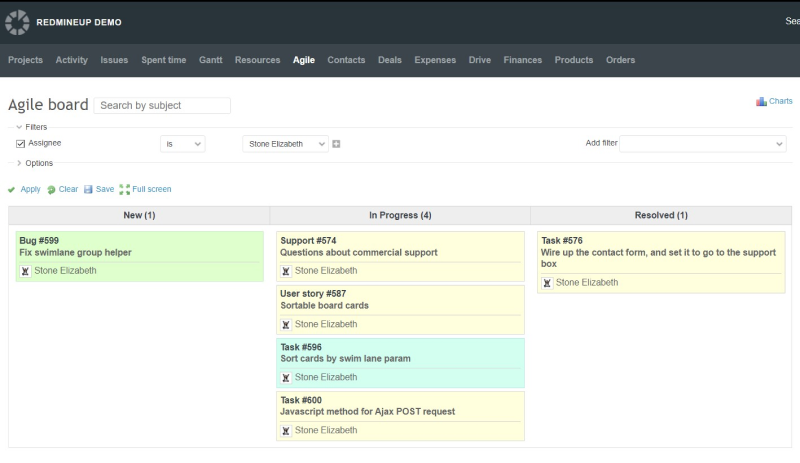
Top-3 Tips:
- Discuss only the work for the day ahead.
- Avoid any technical discussion. It is about updates, not issues. Long conversations are to be held after these daily meetings.
- Use video cameras, if you are working online, to be 100% sure that everyone is engaged in the process.
Learn more about RedmineUP Solutions!
The Third Ceremony: Sprint Review
The third meeting is all about showcasing the results and gathering feedback about the demo version. The team is evaluating their progress and reflecting on what may have been improved. Also, collaborators are deciding what to do during the next sprint.
How is it structured?
The Product Owner asks questions to all the stakeholders involved and gathers insights and thoughts. He should be ready to dispel their doubts as well. The Scrum Master takes responsibility to prepare the whole event.
When does it start and how long does it take?
At the end of every sprint, 1h long.
What parties are involved?
The external and internal stakeholders: the Development Team, Product Owner, Scrum Master, management, clients, and others.
How to manage the ceremony properly?
Go to your Agile board and find the column Done. It contains the information about the work that your team has already completed. Users may filter the results according to an assignee.
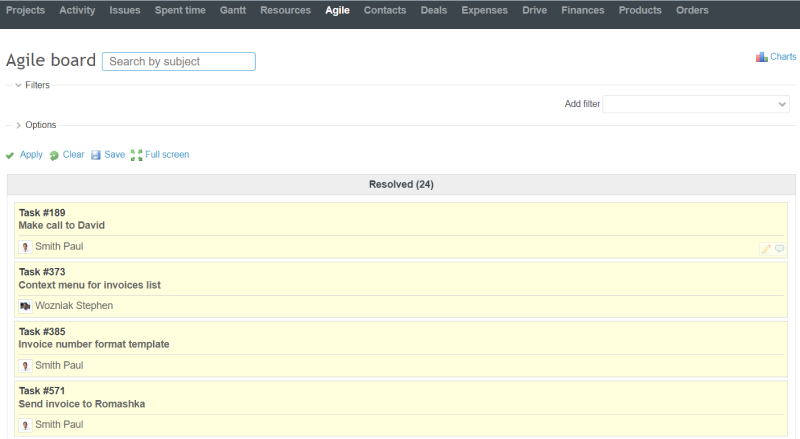
Top-3 Tips:
- Keep the common vibe. Your get-together should be structured the same way as it usually is so that everyone feels comfortable.
- First acknowledge your team’s effort. Compliment their work and only then make comments on what can be improved.
- Focus on customer experience and the delivered business value, not only the functions your demo product has.
The Fourth Ceremony: Sprint Retrospective
The final meeting is aimed at looking at the work with hindsight. What worked out, what did not – in this stage, all these nuances should be talked through. Only this way can the workflow be better next time.
How is it structured?
While the Development Team is discussing which things went well and which ones went wrong, the Scrum Master should try to make the discussion lively by encouraging everyone to share their feelings, not bare facts. Thus, the team needs to realize what they can adopt for the next sprint and what they must miss to avoid making the same mistake.
When does it start and how long does it take?
After the Sprint Review, 45 min-1h long.
What parties are involved?
The Development Team, Scrum Master. The presence of the Product Owner is optional.
How to manage the ceremony properly?
Compare the feedback with the previous Sprint Retrospective ceremony. Do you see the recurring pattern? It is highly important to make notes at every ceremony. For such needs, you can use wikis in Redmine, for example, or simply, document your thoughts in Microsoft Word.
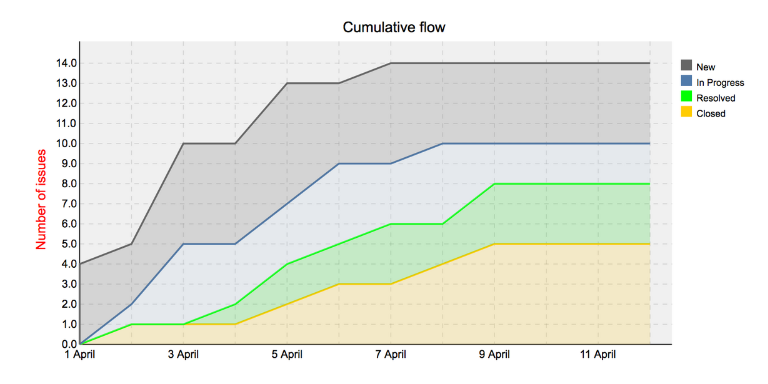
Top-3 Tips:
- Use the RedmineUP charts to track the progress and give your team food for thought.
- Encourage others to be honest. Talk through every process-related difficulty and brainstorm the ideas how it can be solved.
- Create a safe space. Comfort your team by mentioning that their comments will be used to help improve the team progress, not against them.
Migrate to secure hosting
Don't waste your time on Redmine maintenance. Hire experts and focus on your projects
Create a Solid Team Collaboration with RedmineUP!
Stay on the same page with your team throughout all the Agile ceremonies – sign up for our free 15-day trial!
If you want to learn how to use the full-screen function of the Redmine Agile plugin, then watch our video.

